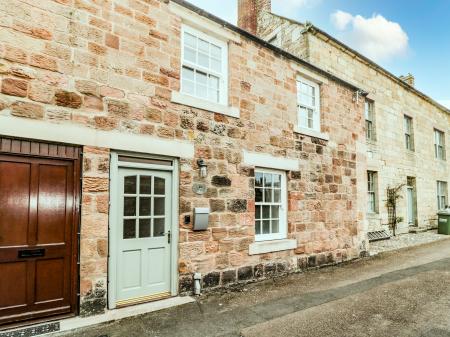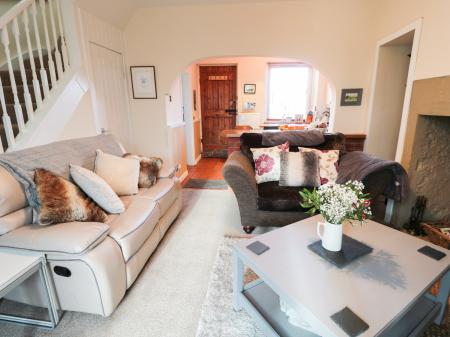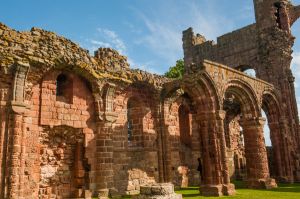
History
Around 635 AD a group of Irish monks under St Aidan were invited by Oswald, King of Northumbria, to settle on the tidal island of Lindisfarne, or Holy Island as it is known today. Aidan and his fellows, though Irish by birth, came from the Celtic Christian centre established on the island of Iona, off the west coast of Scotland.
The most famous of the early Bishops of Lindisfarne was Cuthbert, who came to Lindisfarne in the 670s AD. Cuthbert tried to reform the community along Roman rather than Celtic lines, but the monk's objected. Cuthbert withdrew to a life of prayer on an offshore island. The king pressured Cuthbert to return, which he did in 685 AD when he was named Bishop.
Cuthbert died in 687 AD but when his coffin was exhumed 11 years later his body was found to be in a perfect state of preservation. The monks declared that the purity of Cuthbert's remains was a sign of his saintliness, so he was reburied in a large shrine. Miracles were reported at Cuthbert's, and Lindisfarne became a centre of pilgrimage.
During this period of growing wealth and prestige, Lindisfarne produced one of the great works of art in Celtic Britain; the illuminated manuscript known as the Lindisfarne Gospels. Created from about 710-725 AD, the Gospels are an extraordinary example of early Christian art.
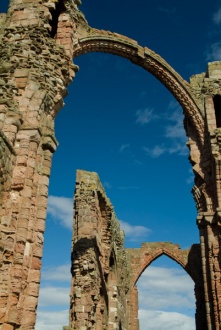
With pilgrims came wealth, grants of land and gifts from kings, but that very wealth made Lindisfarne a target for Viking raiders. The isolation from the mainland of Northumbria that made Lindisfarne so attractive to the early monks also made it more vulnerable to attack from the sea.
Arrival of the Vikings
The Vikings heard of the monastery's wealth and sacked the priory in 793 AD. This was the first major attack by Viking pirates in Western Europe, and it heralded centuries of raids up and down the British coastline.
Eventually the monks fled Viking persecution, carrying Cuthbert's coffin and treasures salvaged from the Priory, they moved temporarily to Norland on the Northumbrian mainland, then in 875 AD moved permanently to Chester-le-Street, near Durham.
The Priory on Lindisfarne may have been unused, but the burial ground was not completely abandoned, as carved stones from the 8th-10th centuries show.
When William the Conqueror moved north to put down a rebellion in his ferocious 'Harrying of the North', the monks of Durham thought it prudent to retreat to Lindisfarne once more. Even though they returned to Durham eventually, the visit prompted them to found a permanent cell on Lindisfarne sometime before 1122 AD.
A new priory church was built by 1150, on the site where Cuthbert's shrine was thought to have stood. By 1172 a full-scale community of monks had been re-established on the island. All the monks came from Durham and stayed on Lindisfarne only 2-3 years before returning to their mother house on the mainland.
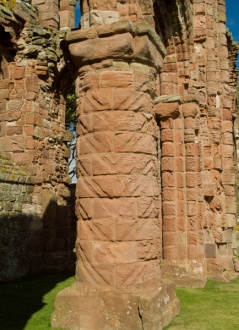
in the priory church
Proximity to Scotland meant that the monks were threatened by raids from the north. They were forced to fortify the Priory, but they could not afford to pay for soldiers to garrison the fortifications.
The Vikings may have forced the monks of Lindisfarne to flee in the 8th century, but Henry VIII went one better and ended the Priory completely in his Dissolution of the Monasteries. The Priory was one of the first to be suppressed, closing its doors in 1537.
Rather than being sold off or left to decay like so many other monasteries the priory ruins were used to help fortify Holy Island against attack.
The passage of time did what Henry VIII did not, and by the 18th century the 12th-century remains were crumbling into decay. Yet that very state of decay made them a magnet for artists, who came to paint the romantic ruins.
The core of the site we see today is the priory church, built around 1150. The most famous feature is the slender 'rainbow arch', which is simply a rib from the vaulting built to support the crossing vault under the tower.
When the tower fell down in the late 18th century the arch somehow survived intact, a soaring, elegant reminder of the beautiful medieval building that once stood here.
Lindisfarne Priory has as much in common with a medieval castle as it does with a monastery. Beside the church are ruins of the domestic quarters, and linked to that are the fortified gateway, defended by an imposing 14th-century barbican projecting out from the inner wall. Beyond this are the outer walls, with a range of buildings erected in the late medieval period as part of the Priory defences. A walkway still exists atop the fortified west wall.
Near the Priory entrance is the lovely parish church of St Mary, and between the church and priory is a Saxon cross base. At the southern edge of the Priory enclosure is a ridge called the Heugh. From the top of the Heugh you can see what remains of the 16th and 17th-century defences built to protect the harbour.
Visiting
I've been to Lindisfarne Priory twice, and both occasions are etched firmly on my memory. Whether it is the inaccessibility of the island or the sheer aura of something special in the air, Lindisfarne is a truly unforgettable place to visit.
The aura of history is tangible. You can look out from the priory and see the rocky islet where St Cuthbert had his hermit cell, and look north to the striking remains of Lindisfarne Castle. This is one of the great historic sites of England.








 We've 'tagged' this attraction information to help you find related historic attractions and learn more about major time periods mentioned.
We've 'tagged' this attraction information to help you find related historic attractions and learn more about major time periods mentioned.